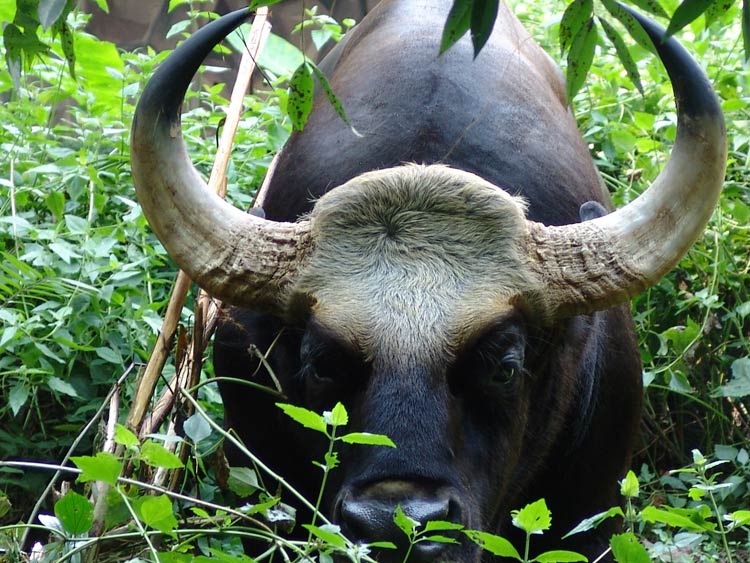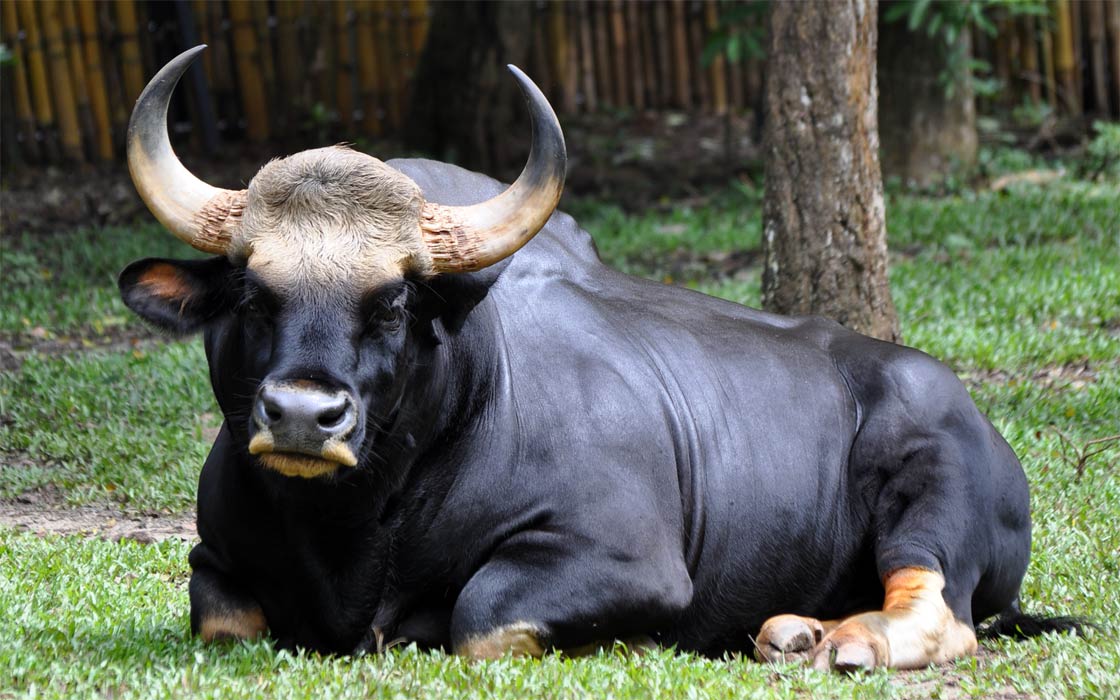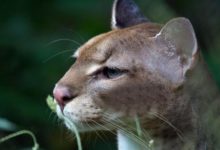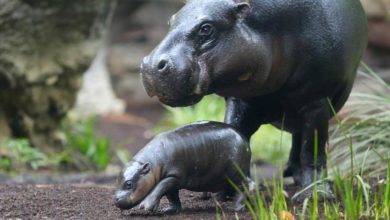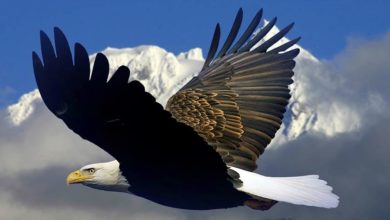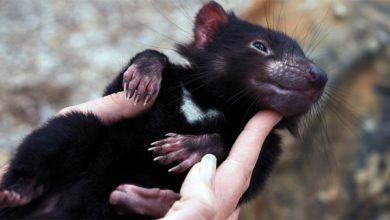From Mythical Beasts to Endangered Species: The Fascinating Story of the Gaur
Deep in the dense and rugged forests of India, a majestic creature roams, a true symbol of strength and resilience – the gaur, also known as the Indian bison. Towering at nearly 7 feet tall (over 2 meters) and weighing up to 1,500 kg (over 3,300 pounds), the gaur (Bos gaurus) is a formidable sight to behold. Its dark brown coat shimmers in the dappled sunlight as it moves gracefully through the undergrowth, its sharp horns and muscular frame a testament to its power and dominance in the animal kingdom.
But beyond its imposing presence, the gaur has a fascinating story to tell, one that speaks to the delicate balance between man and nature and the critical need for conservation efforts to protect this magnificent species. Join us as we explore the world of the gaur and uncover the secrets of this incredible animal.
The gaur, also known as the Indian bison, is a magnificent and imposing species that roams the dense and rugged forests of India and Southeast Asia. It is the largest of all wild cattle species, towering at nearly six feet tall at the shoulder and weighing up to 1,5 tons (3,300 lb). Its dark brown coat shimmers in the sunlight as it moves gracefully through the undergrowth, and its sharp horns and muscular frame are a testament to its power and dominance in the animal kingdom.
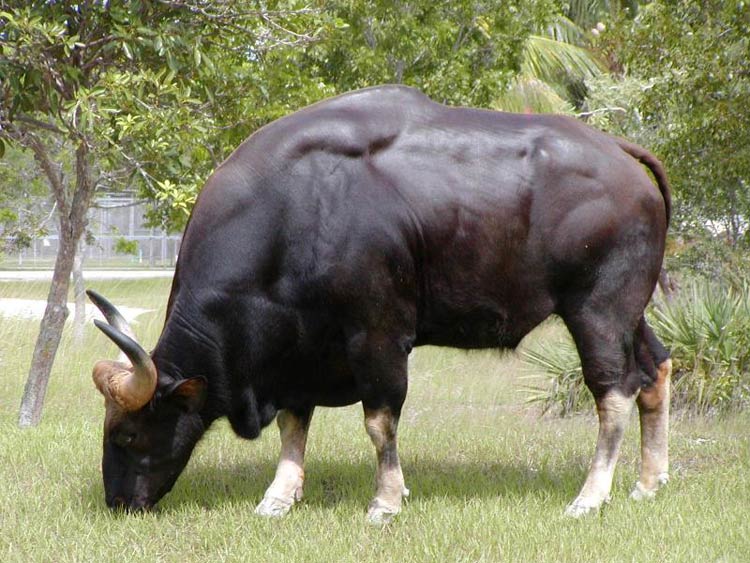
The Gentle Giants: An Introduction to the Mighty Gaur
Males are around one-fourth larger and heavier than females, with an average weight of 1,500 kg (3,307 lb) and an average height of just under 2 meters (6.6 ft) at the top of their muscular hump just behind the shoulder. The male’s girth at its midsection (behind its shoulders) averages about 277 cm (9.1 ft).
Females are slightly smaller, weighing between 440 to 1,000 kg (970 to 2,200 lb) and measuring an average of 168 cm (5.5 ft) at the shoulder. The gaur has a head-and-body length of 250 to 330 cm (8.2 to 10.8 ft) with a 70 to 105 cm (2.3 to 3.4 ft) long tail.
The gaur’s size and strength make it an impressive sight, but its role in its ecosystem is equally important. As a herbivore, the gaur plays a vital role in maintaining the balance of its environment, grazing on grasses and shrubs, and helping to shape the landscape. Unfortunately, like many other large animals, the gaur is threatened by habitat loss and hunting, highlighting the importance of conservation efforts to protect this magnificent species for generations to come.
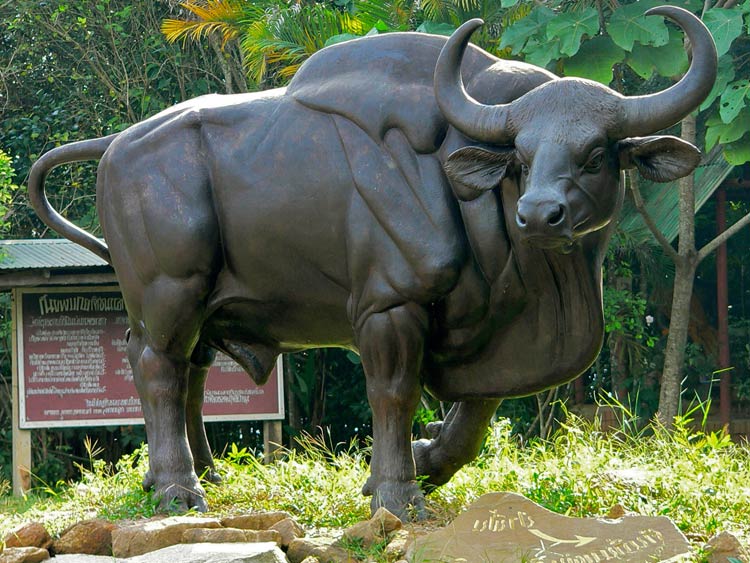
Taxonomy
The gaur, also known as the Indian bison, belongs to the family Bovidae, which includes antelopes, goats, and cattle. Its scientific name is Bos gaurus, with the genus name “Bos” referring to the cattle genus and the species name “gaurus” derived from the Latin word for wild ox or bull.
There are several subspecies of gaur that are recognized by taxonomists, including the Indian gaur (Bos gaurus gaurus), the Southeast Asian gaur (Bos gaurus hubbacki), and the Sri Lankan gaur (Bos gaurus laosiensis). These subspecies differ slightly in physical appearance, distribution, and genetic makeup.
Overall, the gaur is a fascinating and unique member of the Bovidae family, showcasing both the power and grace of wild cattle.
Scientific classification
- Kingdom: Animalia
- Phylum: Chordata
- Class: Mammalia
- Order: Artiodactyla
- Family: Bovidae
- Subfamily: Bovinae
- Genus: Bos
- Species: Bos gaurus

Basic Facts About the Gaur
- The gaur, also known as the Indian bison, is a large, wild cattle species found in the forests of India and Southeast Asia.
- The gaur is the largest wild cattle species in the world, with males weighing up to 1.5 tons and standing nearly six feet tall at the shoulder.
- The gaur has a dark brown coat that shimmers in the sunlight, sharp curved horns, and a muscular frame that showcases its strength and power.
- The gaur is a herbivore, feeding on grasses and shrubs and playing an important role in shaping the landscape and maintaining ecosystem balance.
- The gaur is a social animal that lives in small herds consisting of females and their young, led by a dominant male.
- The gaur is threatened by habitat loss and hunting, and as a result, is listed as a vulnerable species by the International Union for Conservation of Nature (IUCN).
- Efforts to protect the gaur include creating protected areas, reducing human-wildlife conflict, and promoting sustainable use of forest resources.
- The gaur is a fascinating and iconic species, showcasing the beauty and power of the natural world.
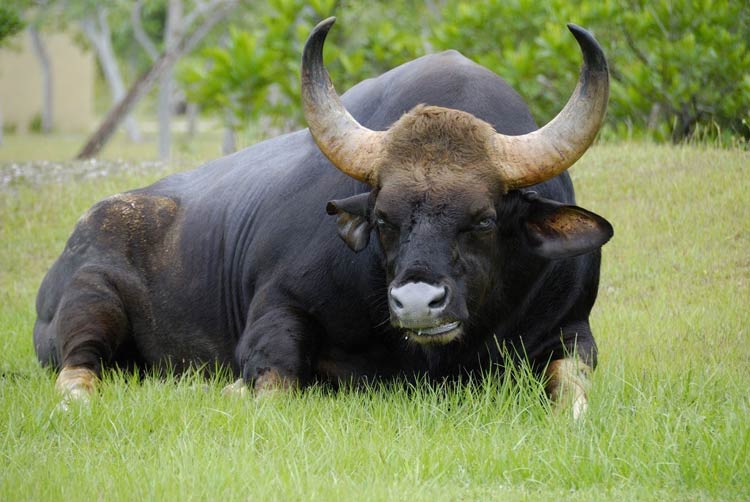
Distribution and habitat
The gaur, or Indian bison, is native to the Indian subcontinent and Southeast Asia. Its range extends from India, Nepal, and Bhutan, through Bangladesh, Myanmar, Thailand, Cambodia, and Laos, and into Malaysia and Indonesia.
The gaur prefers forested habitats, ranging from tropical and subtropical rainforests to deciduous and evergreen forests. It is also found in grasslands, shrublands, and bamboo forests. The gaur’s habitat requirements include a mixture of open and dense forest areas, as well as water sources such as rivers, streams, and pools.
Historically, the gaur was found across much of its range, but today it is threatened by habitat loss due to deforestation, agricultural expansion, and urbanization. As a result, the gaur’s distribution has become fragmented, with isolated populations in protected areas and forest patches. The gaur’s habitat requirements make it a key indicator species for forest health and conservation efforts.
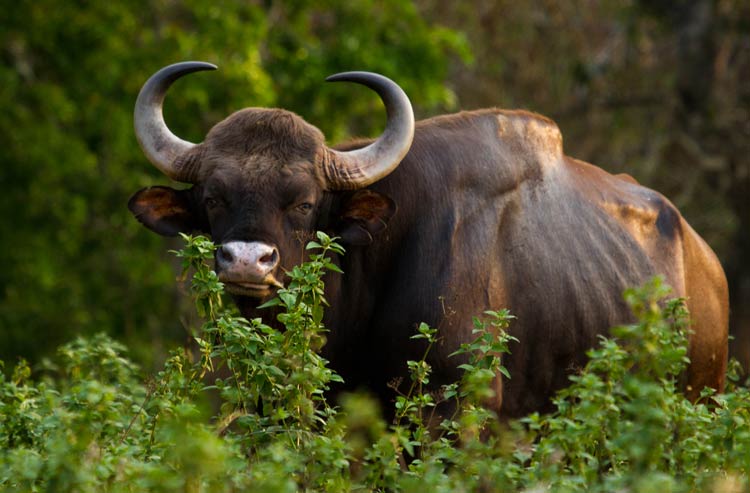
Characteristics
Appearance
The gaur is a large and imposing wild cattle species, known for its muscular build, dark brown coat, and impressive horns.
The gaur has a dark brown coat that shimmers in the sunlight, and a white or yellowish “stocking” on its lower legs. It has a hump at the shoulders, particularly in males, which is formed by a thickening of the vertebrae and muscles. The horns of the gaur are long and curved, with a sharp tip, and are used for defense and display. In males, the horns can grow up to 1 m (3.3 ft) in length and curve outward, while in females they are shorter and straighter.
Overall, the gaur is a striking and impressive animal, perfectly adapted to its forested habitat and playing an important role in shaping the ecosystem around it.
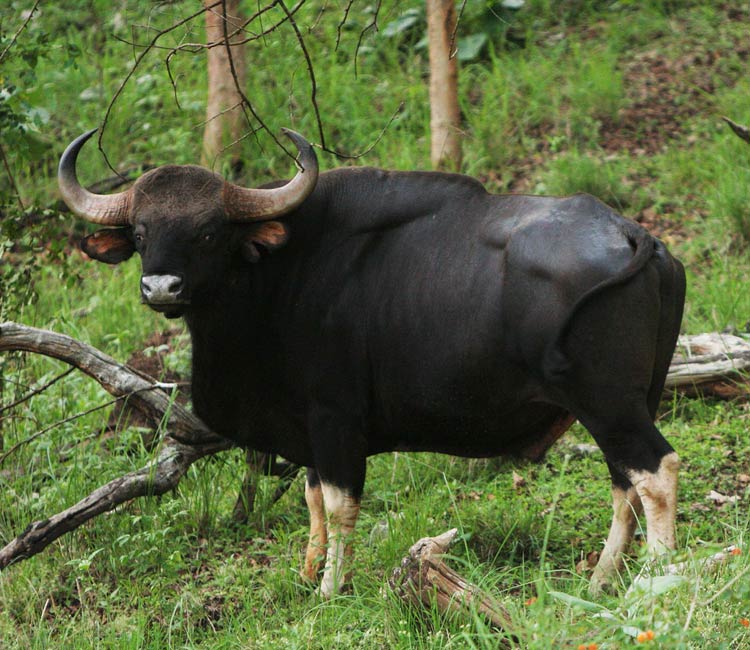
Size
On average, adult males stand about 168 cm (5.5 ft) tall at the shoulder, with females being slightly smaller at about 142 cm (4.7 ft) tall. Males are typically larger and heavier than females, with a body mass ranging from 588 to 1,500 kg (1,296 to 3,307 lb), while females weigh between 440 to 1,000 kg (970 to 2,204 lb).
The gaur has a head-and-body length of 250 to 330 cm (8.2 to 10.8 ft) with a 70 to 105 cm (2.3 to 3.4 ft) long tail, and is 142 to 220 cm (4.7 to 7.2 ft) high at the shoulder, averaging about 168 cm (5.5 ft) in females and 188 cm (6.2 ft) in males. At the top of its muscular hump just behind its shoulder, an average adult male is just under 200 cm (6.6 ft) tall and the male’s girth at its midsection (behind its shoulders) averages about 277 cm (9.1 ft).
Males are about one-fourth larger and heavier than females. Body mass ranges widely from 440 to 1,000 kg (970 to 2,200 lb) in adult females and 588 to 1,500 kg (1,296 to 3,307 lb) in adult males. In general, measurements are derived from gaurs surveyed in India. Indian gaur males averaged about 1,500 kg (3,307 lb) (in a sample of 13) and females weigh a median of approximately 700 kg (1,543 lb). In China, the shoulder height of gaurs ranges from 165 to 220 cm (5.4 to 7.2 ft), and bulls weigh up to 1,500 kg (3,307 lb).
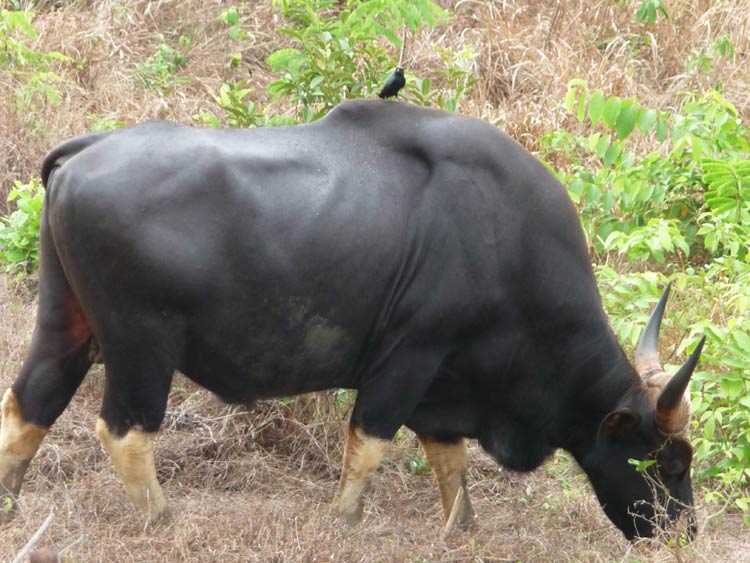
Behavior, Lifestyle and ecology
The gaur is a social animal that typically lives in small groups, or herds, consisting of females and their young led by a dominant male. The male, or bull, defends his territory and herd from rivals with threatening displays, vocalizations, and physical combat using his horns.
The gaur is primarily active during the day, spending its time foraging for food and socializing with other members of the herd. The gaur is a herbivore, feeding on grasses, leaves, and other plant material, and playing an important role in shaping the forest ecosystem through its grazing and browsing.
The gaur is an important prey species for large predators such as tigers, leopards, and crocodiles, and its presence in a forest ecosystem can have a cascading effect on the abundance and distribution of other species.
The gaur is known to communicate with other members of its herd using vocalizations, body language, and scent marking. For example, males may make loud grunts and barks to establish dominance or attract females during mating season.
The gaur has a relatively slow reproductive rate, with females giving birth to a single calf after a gestation period of around 270 days. The calf remains with its mother for up to two years, learning important social and survival skills from the herd.
The gaur is a fascinating and complex animal, perfectly adapted to its forest habitat and playing a vital role in maintaining ecosystem health and balance.
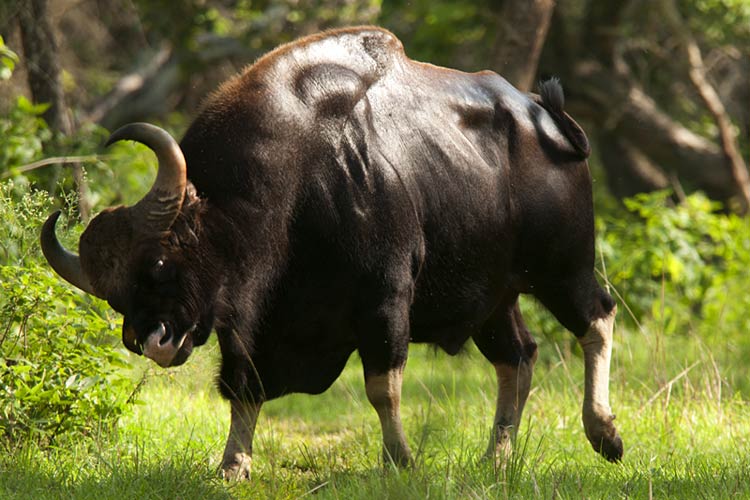
Diet
The gaur is a herbivore with a varied diet, feeding on a wide range of plant material including grasses, leaves, fruit, and flowers. Its diet can vary depending on the season and availability of food in its habitat.
In tropical forests, where the gaur is often found, it feeds on a variety of tree and shrub species, as well as bamboo shoots. During the dry season, when food may be scarce, the gaur may also eat bark and woody material.
The gaur has a complex digestive system that allows it to break down tough plant material, such as fibrous grasses and leaves, using specialized microbes in its stomach. It has a four-chambered stomach, similar to that of a cow, which allows it to ferment and digest plant material over an extended period.
Overall, the gaur plays an important role in shaping the forest ecosystem through its grazing and browsing, helping to maintain plant diversity and balance in the forest understory.
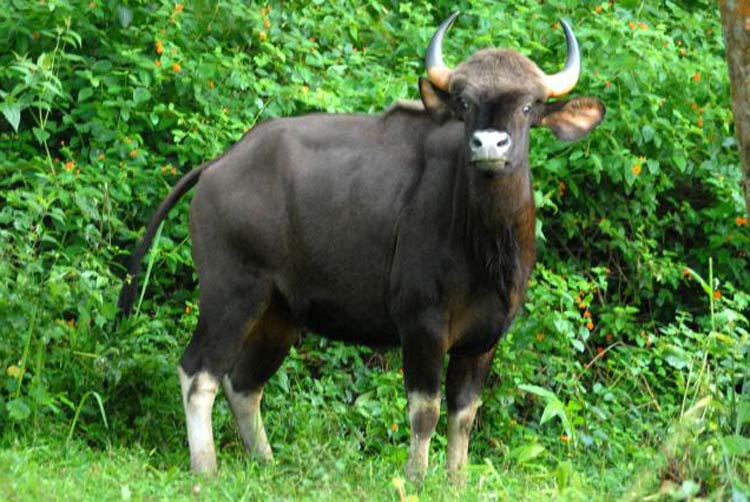
Reproduction and parenting
The gaur has a relatively slow reproductive rate, with females giving birth to a single calf after a gestation period of around 270 days. Mating typically occurs during the rainy season when food is abundant, and males compete for access to females by engaging in physical combat and displaying their dominance through vocalizations and body language.
After birth, the calf remains with its mother for up to two years, learning important social and survival skills from the herd. The mother gaur is highly protective of her calf and will defend it fiercely against predators or other threats.
Female gaurs reach sexual maturity at around two to three years of age, while males may not reach maturity until six to eight years of age. Adult bulls may engage in mating with several females, and competition for access to females can be intense.
Overall, the gaur’s slow reproductive rate and complex social behavior make it an important species to study in terms of understanding the factors that affect population growth and sustainability in the wild.
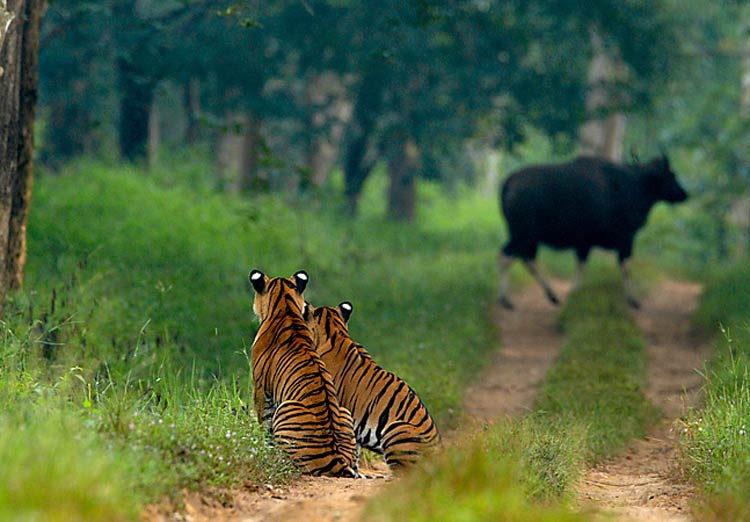
Predators and Threats
The gaur’s large size and strength make it a formidable opponent for most predators. However, it is still vulnerable to predation by large carnivores such as tigers, leopards, dholes (wild dogs), and crocodiles. Young calves may also be taken by smaller predators such as jackals and pythons.
Human activities are the greatest threat to gaur populations. Habitat loss and fragmentation due to agriculture, logging, and human settlement have greatly reduced the gaur’s range and population size. Hunting for meat, trophies, and body parts has also contributed to the decline of gaur populations in some areas.
In addition, the gaur is susceptible to diseases transmitted from domestic livestock, which can have devastating effects on wild populations. Climate change is also likely to impact gaur populations by altering their habitat and food availability.
Conservation efforts are focused on protecting and restoring gaur habitat, reducing human-wildlife conflicts, and reducing poaching and illegal hunting. In some areas, captive breeding programs have been established to help boost gaur populations. Overall, the conservation of the gaur is important not only for its own survival but also for maintaining the health and biodiversity of forest ecosystems.

Interactions with humans
The gaur has had a complex relationship with humans throughout history. In some cultures, the gaur is revered as a symbol of strength and power, while in others it is viewed as a pest and threat to crops and livestock.
In many areas, the expansion of human settlements and agriculture has brought humans into direct conflict with gaur populations. The destruction of natural habitats and the fragmentation of gaur populations have also increased the incidence of human-gaur conflicts. In response, many governments and conservation organizations have implemented measures to mitigate conflicts, such as fencing, crop diversification, and compensation schemes for farmers who experience crop damage.
The gaur has also been the target of hunting for meat and sport. In some areas, hunting of gaurs has been regulated or banned altogether, while in others it remains a threat to gaur populations.
On the positive side, the gaur’s impressive size and strength make it an important draw for ecotourism in some areas, generating income for local communities and promoting conservation efforts.
The key to successful coexistence between humans and gaurs is the protection and restoration of the gaur’s natural habitats and the implementation of measures to reduce human-gaur conflicts.
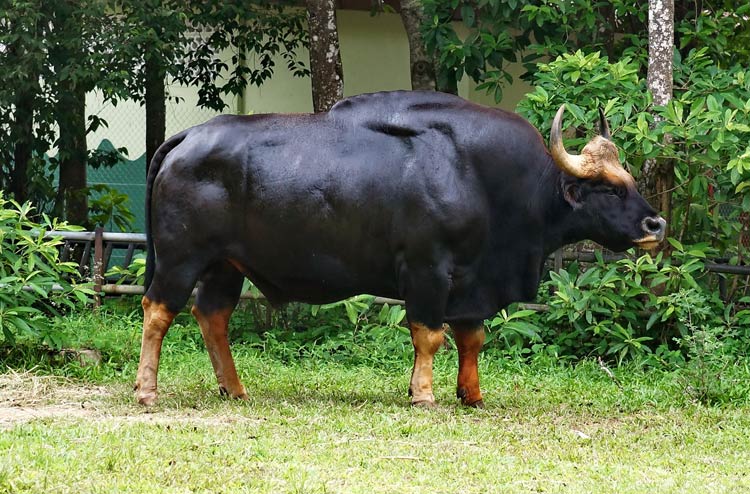
Population
The population of gaur is declining and the species is considered vulnerable to extinction by the International Union for Conservation of Nature (IUCN). The total population size is unknown, but it is estimated to be fewer than 21,000 individuals across its range, which includes India, Nepal, Bhutan, Bangladesh, Myanmar, Thailand, Cambodia, Laos, and Vietnam.
Habitat loss, fragmentation, and degradation are the primary threats to gaur populations. In addition, poaching and hunting, competition with domestic livestock, and disease transmission from livestock are also significant threats to gaur populations.
Conservation efforts are underway to protect and restore gaur habitats, mitigate human-gaur conflicts, and reduce hunting and poaching. Captive breeding programs have also been established in some areas to boost gaur populations. Despite these efforts, the gaur remains at risk of extinction and continued conservation efforts are necessary to ensure its survival in the wild.
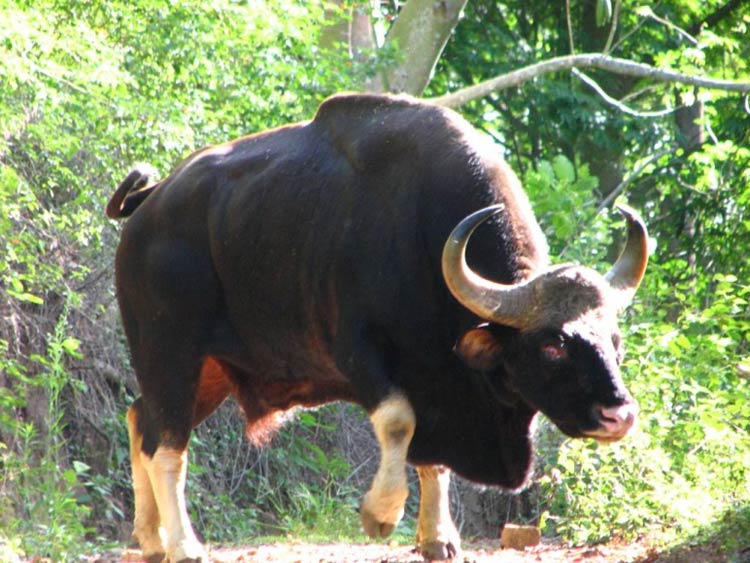
Status and conservation
The gaur is listed as “vulnerable” on the IUCN Red List of Threatened Species, indicating that it faces a high risk of extinction in the wild.
The primary threats to gaur populations are habitat loss, degradation and fragmentation due to human activities, such as deforestation, agriculture, and development. Poaching and hunting are also significant threats to gaur populations, as is competition with domestic livestock and disease transmission from livestock.
Conservation efforts for the gaur include habitat protection and restoration, reduction of human-gaur conflicts, and regulation of hunting and poaching. Several protected areas have been established across the gaur’s range, including national parks, wildlife sanctuaries, and reserves. Captive breeding programs have also been established in some areas to boost gaur populations.
Despite these efforts, the gaur remains at risk of extinction and continued conservation measures are necessary to ensure its survival in the wild. Ongoing research and monitoring are also needed to better understand the population dynamics, behavior, and ecology of the gaur, and to inform conservation strategies.
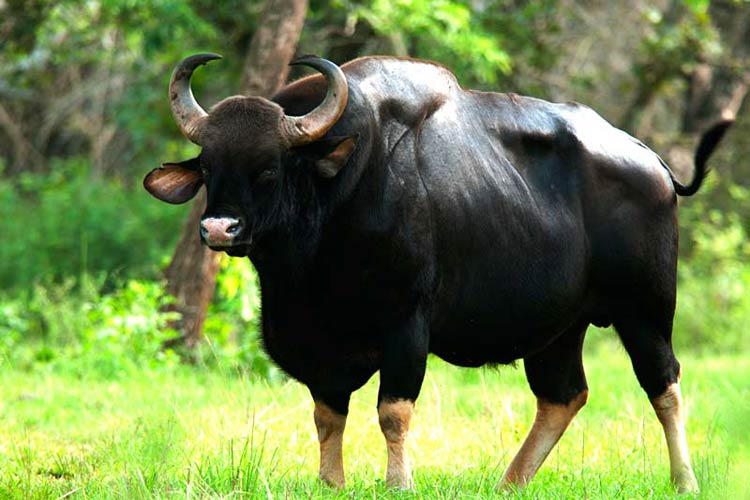
The gaur in numbers / dimensions
- Head-and-body length: 250 to 330 cm (8.2 to 10.8 ft)
- Tail length: 70 to 105 cm (2.3 to 3.4 ft)
- Height at shoulder: 142 to 220 cm (4.7 to 7.2 ft)
- Girth at midsection (males): around 277 cm (9.1 ft)
- Weight
- Females: 440 to 1,000 kg (970 to 2,200 lb)
- Males: 588 to 1,500 kg (1,296 to 3,307 lb)
- Shoulder height in China: 165 to 220 cm (5.4 to 7.2 ft)
- Bull weight in China: up to 1,500 kg (3,307 lb)
- Lifespan: 20-25 years in the wild
It’s important to note that these measurements are based on averages and can vary depending on factors such as age, sex, and location.
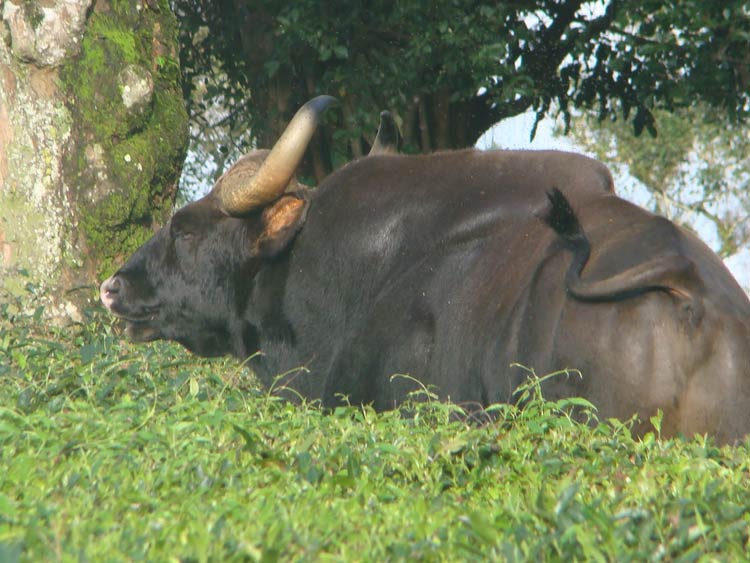
The gaur in culture
The gaur has played a significant role in the cultures of several countries across its range. In India, for example, the gaur has been depicted in ancient art and is considered a sacred animal by some Hindu communities. In traditional Indian medicine, various parts of the gaur’s body are believed to have medicinal properties.
The gaur has also been featured in literature and popular culture. The gaur is the state animal of several Indian states, including Goa, Karnataka, and Kerala. The gaur has also been depicted in various works of art and literature, such as Rudyard Kipling’s “The Jungle Book.” In modern times, the gaur has been the focus of various conservation efforts and is recognized as an important part of the natural heritage of the countries where it is found.
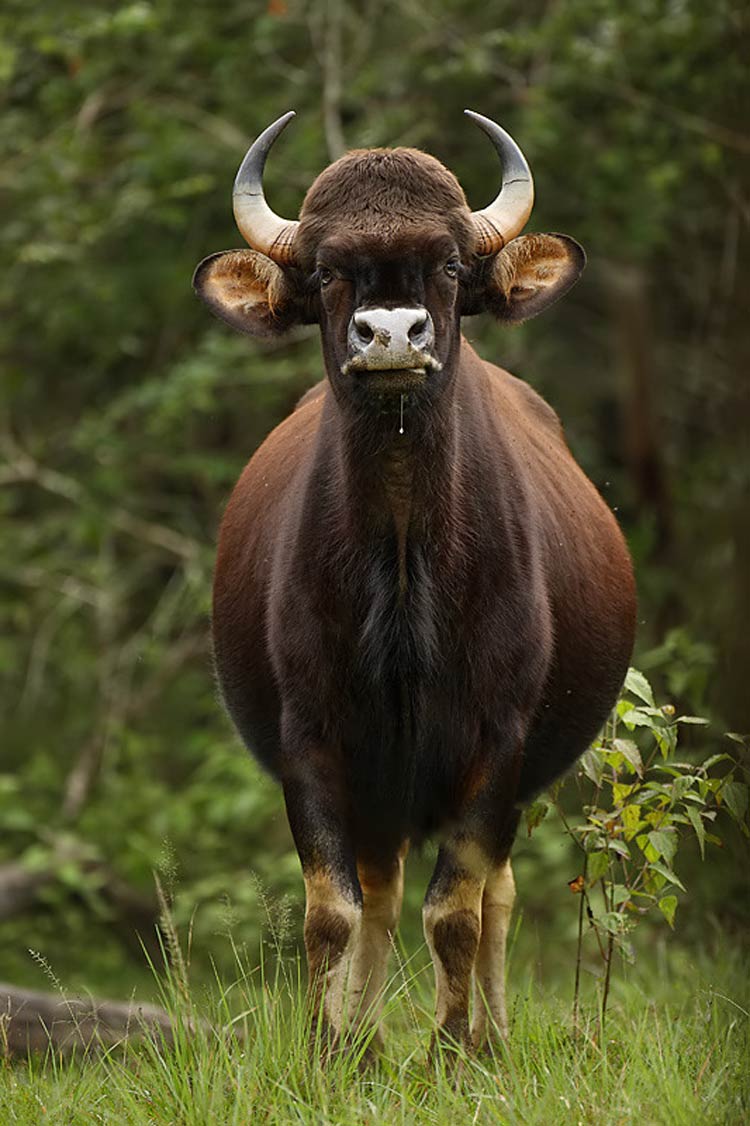
The gaur in movies
While the gaur has not been a major character in many movies, it has been featured in a few films and documentaries.
One example is the 1971 documentary film “The Great Indian Elephant”, which features a scene of a gaur defending itself against a group of wild dogs. In the 2017 Indian movie “Baahubali 2: The Conclusion”, a character rides on the back of a CGI-animated gaur during a battle scene. The gaur has also made brief appearances in other films such as “The Jungle Book” (2016) and “The Second Jungle Book: Mowgli & Baloo” (1997).
Overall, the gaur’s appearances in movies have been relatively limited, but its imposing size and strength make it a compelling animal to include in action and adventure scenes.

Domestication of the gaur
The gayal (Bos frontalis), also known as the Drung ox or mithun
The gaur has been domesticated to some extent in parts of Southeast Asia, resulting in the creation of a domesticated form known as the gayal (Bos frontalis). The gayal, also known as the Drung ox or mithun, is believed to have been domesticated thousands of years ago by the local tribes in the region.
The gayal is similar in appearance to the gaur but is smaller in size, with a less prominent hump and shorter horns. It has a domesticated temperament and is used by some communities for meat, milk, and as a draft animal.
While the gayal is domesticated in some regions, it is still considered a wild animal in others and is hunted for its meat and other products. The conservation status of the gayal is currently unclear, as it is not well-studied or managed. However, efforts are underway in some areas to promote the conservation and sustainable use of the gayal, which is an important part of the cultural and ecological heritage of the region.
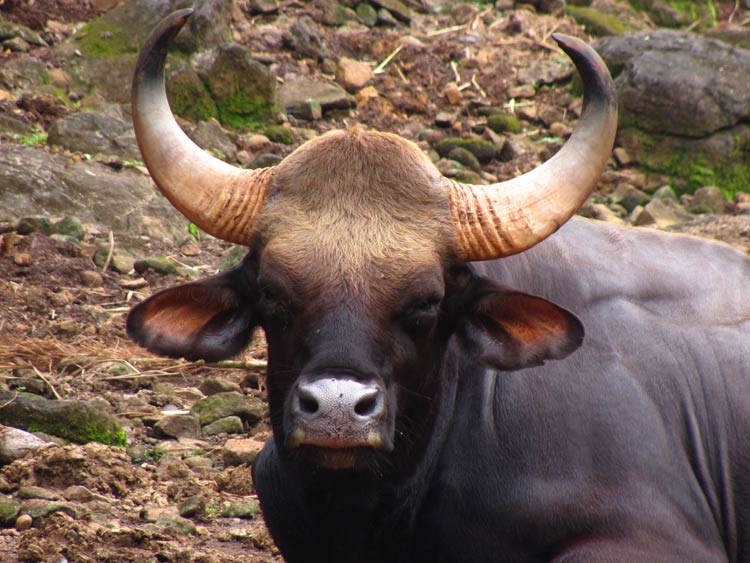
Interesting facts about the gaur
- The gaur is the largest wild bovid in the world, even larger than the African buffalo.
- The gaur’s coat color varies from dark brown to black, and its legs are usually lighter in color.
- The gaur has a distinctive ridge of muscle, called a hump, behind its shoulders that gives it its powerful appearance.
- The gaur is a social animal and lives in herds of up to 40 individuals, usually consisting of females and their offspring.
- While the gaur is primarily a herbivore, it has been known to eat small mammals and birds on occasion.
- The gaur is a strong swimmer and can cross rivers with ease.
- The gaur has few natural predators, but is occasionally hunted by tigers and leopards.
- The gaur’s low reproductive rate and habitat loss due to human activities are the primary threats to its survival in the wild.
- The gaur is revered in some cultures and is considered a sacred animal by certain Hindu communities in India.
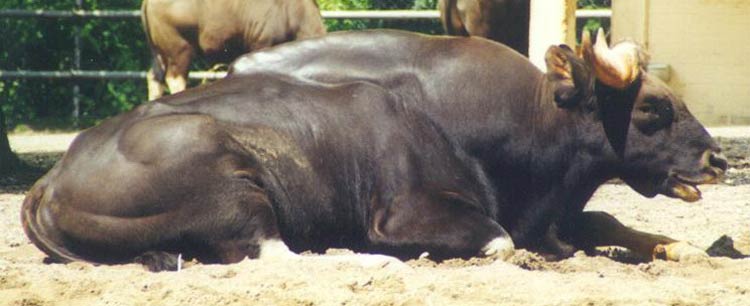
Q&A (questions and answers) about the gaur
Q: What is a gaur?
A: A gaur (Bos gaurus) is a large, wild bovine native to Southeast Asia, including India, Nepal, Bhutan, and Thailand.
Q: How big is a gaur?
A: A gaur is one of the largest wild bovines in the world, with males weighing up to 1,500 kg (3,300 lb) and females weighing up to 1,000 kg (2,200 lb). They stand up to 220 cm (7.2 ft) tall at the shoulder and have a head-and-body length of 250 to 330 cm (8.2 to 10.8 ft).
Q: What does a gaur eat?
A: A gaur is primarily a herbivore and feeds on a variety of grasses, leaves, and fruits.
Q: How long does a gaur live?
A: A gaur typically lives for around 20-25 years in the wild.
Q: Is the gaur endangered?
A: Yes, the gaur is considered vulnerable to extinction due to habitat loss and hunting.
Q: What is a gayal?
A: A gayal (Bos frontalis), also known as the Drung ox or mithun, is a domesticated form of the gaur that is found in parts of Southeast Asia. It is used for meat, milk, and as a draft animal.
Q: What is the gaur’s habitat?
A: The gaur’s natural habitat includes tropical and subtropical forests, grasslands, and shrublands.
Q: How does a gaur protect itself from predators?
A: The gaur has few natural predators due to its large size and strength. However, tigers, leopards, and wild dogs may prey on young or weak individuals. Gaurs use their sharp horns and powerful bodies to defend themselves against predators.
Q: How do gaurs communicate with each other?
A: Gaurs use a variety of vocalizations, including grunts, moos, and bellows, to communicate with each other. They also use body language and scent marking to signal dominance and establish social hierarchies.
Q: Are gaurs social animals?
A: Yes, gaurs are social animals and typically live in herds of up to 40 individuals. The herds are led by a dominant male and consist of females and their young.
Q: Can gaurs interbreed with other bovines?
A: Yes, gaurs can interbreed with domestic cattle to produce hybrid offspring known as “cattle-gaur” or “beefalo.” However, these hybrids are usually sterile and are not considered a separate species.
Q: Are gaurs aggressive towards humans?
A: Gaurs are generally shy and avoid human contact. However, they may become aggressive if they feel threatened or cornered, especially if they are protecting their young. It is important to give gaurs plenty of space and avoid approaching them in the wild.
